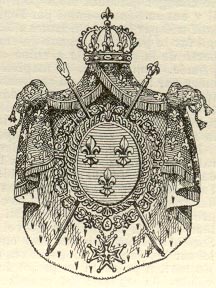Wednesday, June 9

Pickled Royal Hearts
The pickled heart of Louis XVII, the petit dauphin so famed in story and legend for his purported escape from the Temple prison, was laid to rest yesterday in the royal crypt of the old abbey church of St. Denis, the former pantheon of the Bourbons. Two centuries of rumor, fueled by perhaps over-eager conspiracy theorists and romantics, would have it that the heart is a fake, for the sickly ten-year-old boy who died of tuberculosis two years after seeing Louis XVI and Marie-Antoinette felled by the guillotine, was claimed by some to be an impostor.
The real heir, like the ill-fated Grand Duchess Anastasia Romanov, was supposed to have escaped; indeed about 100 claimants showed up after the fall of Napoleon in 1814. One came from, of all places, the Seychelles, while another proved to be a half-Indian Wisconsin missionary. Mark Twain even threw one, an unscrupulous showman peddling himself as the "Royal Nonesuch," into the pages of Huckleberry Finn. And then there was Karl Wilhelm Naundorff, who in death even fooled his own coroner.
Louis-Charles, Duke of Normandy and Dauphin of France, was taken from his royal mother on July 3, 1793 and died on June 12, 1795. A death certificate was drawn up for "Louis Charles Capet, ten years old two months," the "son of Louis Capet, last king of the French." Another "official" death certificate can be found for the Dauphin, dated August 12, 1845, for "Charles Louis de Bourbon, Duke of Normandy, Louis XVII, having been known under the name of Charles Guillaume Naundorff." This German watchmaker's claims had actually been accepted well into this century by some; indeed, genetics did not explode his cause until 1955, when a bone unearthed from his tomb was tested against the preserved capillaries of two archduchesses, sisters of the doomed Marie-Antoinette, which had remained all this time in an Austrian convent. Karl Naundorff was no royal, it turns out. Nonetheless, his tombstone still reads, extraordinarily, HERE LIES LOUIS XVII, DUKE OF NORMANDY, KING OF FRANCE AND NAVARRE. Even more remarkable is the fact his descendents to this day audaciously call themselves de Bourbon. Few take them seriously.
The current identification of the heart is irrefutable, for all the bizarre permutations the pickled organ went through before it reached its funal resting place. The royalist doctor, Pelletan, who performed the autopsy, hid it in his hankerchief and smuggled it out of the Temple; it was later stolen in turn by one of his assistants, whose wife returned it to the doctor. It later passed to the Archbishop of Paris, who fled the country in the midst of the July Revolution of 1830, when a violent mob broke into his palace and smashed the reliquary containing the heart to bits.
Dr. Pelletan's son saved a few dried slices of the heart, which ended up being owned by the head of the modern-day French legitimist party, the Duke of Beuffremont, who had received it from the Spanish Bourbons in 1975. He authorized a round of tests recently, which required obtaining samples of the wizened relic by cutting the now-hardened heart (reportedly as tough as wood) with a saw. They turned out positive, and so, with pomp and as much royal ceremony as this dessicated age could summon, they entombed him only a day ago, alongside his beloved father and mother, the last casualty of the French Revolution.
Of course, science will never convince some. The little Prince Dmitri of Uglich, slain by Boris Godunov and later canonized by the Russian Orthodox Church, was the focus of not one but two impostors, the first one being executed and then having his remains loaded into a cannon and shot towards Poland; this did not prevent a second False Dmitri from turning up claiming to have impossibly survived that most peculiar fusillade--and the first False Dmitri's wife actually believed him. There will always be denial, somehow, somewhere. A few skeptics prefer to claim the little heart is from Louis XVI's brother rather than his son, for all the weird historical anachronisms that brings up.
People are odd that way: they like romance, they like conspiracy and unsolved mysteries, and while perhaps a preserved heart and the purple splendor of a Bourbon funeral might provide all the extravagance imagination would require, there will probably always be a determined knot of people who still think the little Bourbon slipped free and wanders in the trackless forests of the imagination, whether in the Seychelles, in Wisconsin or amid the riverboat toughs of Twain's Mississipppi.












